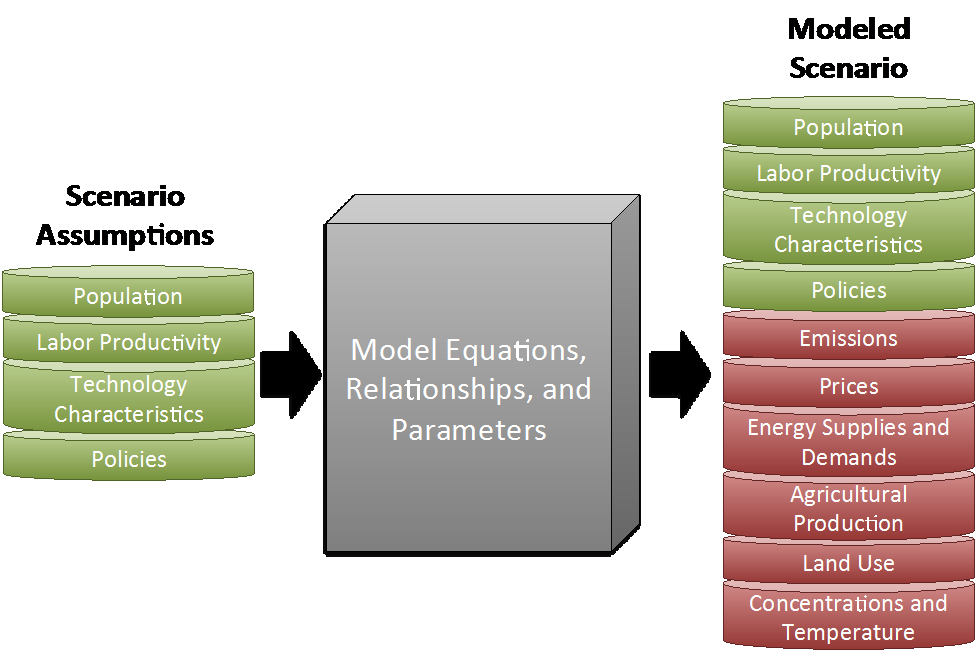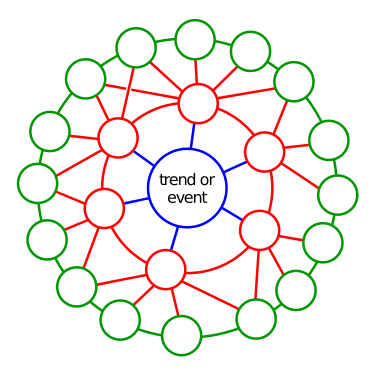Metoder
Backcasting
CLA
Delphi
Emancipatory Futures Studies
Futures techniques
www.en.wikipedia.org/wiki/Futures_techniques
1.1 Delphi method
Futures Methodology
Futures Wheel
Glenn, J. C. (2009). Futures Wheel. Futures Research Methodology (Version 3.0), AC/UNU Millennium Project, Washington, D.C.
... The Future wheel is a method for graphical visualisation of direct and indirect future consequences of a particular change or development. It was invented by Jerome C. Glenn in 1971.
www.en.wikipedia.org/wiki/Futures_wheel
Futures Research Methodology
Gordon, T. J., & Glenn, J. C. (2003). Integration, comparisons, and frontiers of futures research
methods. Futures Research Methodology (Version 2.0), AC/UNU Millennium Project, Washington,
DC.
J.C. Glenn, T.J. Gordon (Eds.), Futures Research Methodology Version 3.0, The Millennium Project, Washington, DC, 2009.
J.C. Glenn, The futures wheel, in: J.C. Glenn, T.J. Gordon (Eds.), Futures Research Methodology Version 3.0, The Millennium Project, Washington, DC, 2009
P. Bishop, A. Hines, T. Collins, The current state of scenario development: An overview of techniques, Foresight 9 (1) (2007) 5–25.
O. Markley, A new methodology for anticipating STEEP surprises, Technological Forecasting & Social Change 78 (2011) 1079–1097.
www.imaginalvisioning.com ... pdf
P. Bishop, A. Hines, Teaching about the Future: The Basics of Foresight Education, Palgrave Macmillan, Houndmills, UK, 2012, 9.
E. Hiltunen, Good sources of weak signals: a global study of where futurists look for weak signals, Journal of Futures Studies 12 (4) (2008) 21–44.
Causal layered analysis
Sohail Tahir Inayatullah: Causal Layered Analysis (CLA)
Poststructuralism as method
Causal layered analysis consists of four levels:
1: the litany: quantitative trends ...
2: social causes: economic, cultural, political ...
3: discourse/worldview that supports and legitimates ...
4: myth/metaphor: the collective archetypes ...
Scenarios are different at each level. Litany type scenarios are more instrumental, social level scenarios are more policy oriented, and discourse/worldview scenarios intend on capturing fundamental differences. Myth/metaphor type scenarios are equally discrete but articulate this difference through a poem, a story, an image or some other right-brain method.
www.metafuture.org/Articles/CausalLayeredAnalysis.htm
Sohail Tahir Inayatullah
www.en.wikipedia.org/wiki/Sohail_Inayatullah
Creating a shared narrative: the use of causal layered analysis to explore value co-creation in a novel service ecosystem
... the interviews were analysed with causal layered analysis (CLA), a technique developed for opening up the constitutive discussions among the actors involved in the value co-creation process
www.eujournalfuturesresearch.springeropen.com/articles/10.11 ...
Causal layered analysis (CLA)
www.en.wikipedia.org/wiki/Causal_layered_analysis
Riedy C (2008) An integral extension of causal layered analysis. Fut 40:150–159
CLA 2.0: Transformative research in theory and practice
Inayatullah, S and Milojevic, I.
Global Transformations and World Futures - Volume I
Sohail Tahir Inayatullah, ed. 2009. EOLSS publishers/UNESCO.
www.books.google.dk/books ...
Global Transformations and World Futures - II
Sohail Tahir Inayatullah, ed.
www.books.google.dk/books ...
Global Transformations and World Futures - I and II, content
www.eolss.net ... pdf
Richard Slaughter, "Developing and Applying Strategic Foresight
Jose W. Ramos
Inayatullah's work on CLA was examined in a book by Jose W. Ramos in 2003
www.en.wikipedia.org/wiki/Sohail_Inayatullah
Ramos, Jose W. (2003). "From critique to cultural recovery: Critical futures studies and casual layered analysis". Australian Foresight Institute.
Ramos, J. 2004: Causal layered analysis and deep participation, in: S. Inayatullah (Ed.), The Causal Layered Analysis
Reader, Tamkang University, Taiwan, 2004.
Ramos, Jose W. (2005). Dimensions in the confluence of futures studies and action research
www.actionforesight.net ... pdf
Futures wheel
Wild cards
Definition
“A wild card is a future development or event with a relatively low probability of occurrence, but a likely high impact on the conduct of business”. (Steinmüller 2003).
Wild card or STEEP surprise
... In technological forecasting and futures research on social change, the term wild card (a.k.a.
disruptor or STEEP surprise), traditionally refers to a plausible future event that is estimated to
have low probability but high impact should it occur.
1. A Type II Wild Card, defined as having high probability and high impact as seen by experts if
present trends continue, but low credibility for non-expert stakeholders of importance.
2. A four-level typology of wild cards, leading to a systematic methodology for monitoring the
emerging awareness and credibility of high probability disruptors and for assessment of
stakeholder-specific views about them.
STEEP: Social, Technological, Economic, Environmental and Political.
www.en.wikipedia.org/wiki/Futures_studies
References
O. Markley 2011, A new methodology for anticipating STEEP surprises
Technological Forecasting & Social Change 78 (2011) 1079–1097.
www.imaginalvisioning.com ... pdf
The Future as Wild Card: A Short Introduction to a New Concept
Dr. Karlheinz Steinmüller 2003.
www.steinmuller.de ... pdf
Taleb, N.N. (2007). The Black Swan: The Impact of the Highly Improbable. Random House, New York.
www.en.wikipedia.org/wiki/The_Black_Swan ...
Theory of Societal Collapse
Tainter’s Model
Tainter describes his model in his 1988 book “The Collapse of Complex Societies” (Tainter 1988). Here is an excerpt from the book.
More complex societies are more costly to maintain than simpler ones, requiring greater support levels per capita. <..> It is the thesis of this chapter that return on investment in complexity varies, and that this variation follows a characteristic curve. More specifically, it is proposed that, in many crucial spheres, continued investment in sociopolitical complexity reaches a point where the benefits for such investment begin to decline, at first gradually, then with accelerated force. Thus, not only must a population allocate greater and greater amounts of resources to maintaining an evolving society, but after a certain point, higher amounts of this investment will yield smaller increments of return. Diminishing returns, it will be shown, are a recurrent aspect of sociopolitical evolution, and of investment in complexity.
The Collapse of Complex Societies
Joseph A. Tainter. CUP Press 1988.
www.books.google.dk ...
Why do Societies Collapse? Diminishing Returns are a Key Factor, a New Study Says
Ugo Bardi 2019.
www.resilience.org/stories/2019-01-24 ...
Toward a General Theory of Societal Collapse: A Biophysical Examination of Tainter’s Model of the Diminishing Returns of Complexity
www.link.springer.com ...
Bardi U (2017) The Seneca effect why growth is slow but collapse is rapid. Springer, Berlin.
Catton W (1982) Overshoot, the ecological basis of revolutionary change. Illini Books, Champaign.
Cline EH (2014) 1177 B.C.: the year civilization collapsed. Princeton University Press, Princeton.
Diamond J (2005) Collapse societies choose to fail or succeed. Penguin Group, New York.
Gladwell M (2002) The tipping point: how little things can make a big difference: Malcolm. Back Bay Books, Columbus.
Gupta AK, Hall CAS (2011) A review of the past and current state of EROI data. Sustainability 3:1796–1809.
McConnell JR, Wilson AI, Stohl A, Arienzo MM, Chellman NJ, Eckhardt S, Thompson EM, Pollard AM, Steffensen JP (2018) Lead pollution recorded in Greenland ice indicates European emissions tracked plagues, wars, and imperial expansion during antiquity. Proc Natl Acad Sci USA 115:5726–5731
Mobus GE, Kalton MC (2015) Principles of system science. Springer, Berlin.
Motesharrei S, Rivas J, Kalnay E (2014) Human and nature dynamics (HANDY): modeling inequality and use of resources in the collapse or sustainability of societies. Ecol Econ 101:90–102.
Pearl J, Mackenzie D (2018) The book of why: the new science of cause and effect. Basic Books, New York.
www.books.google.dk/books ...
Reynolds DB (2016) Cold war energy: the rise and fall of the Soviet Union. Alaska Chena LLC, Anchorage, Alaska.
Sverdrup HU, Koca D, Ragnarsdóttir KV (2013) Peak metals, minerals, energy, wealth, food and population: urgent policy considerations for a sustainable society. J Environ Sci Eng 2:189–222.
Taagepera R (1979) Size and duration of empires: growth-decline curves, 600 BC to 600 AD. Soc Sci Hist 3:115.
Tainter JA (2008) Collapse sustainability, and the environment: how authors choose to fail or succeed. Rev Anthropol 37:342–371.
References
www.link.springer.com/article/10 ...
Integral futures
Integral futures framework
The Evolution of Integral Futures - A Status Update
Terry Collins and Andy Hines 2010
... Integral Futures is an approach to futures studies that adapted Ken Wilber’s Integral Theory to futures practice.
Integral Theory suggests that four irreducible perspectives (subjective, intersubjective, objective, and interobjective) should be consulted when attempting to fully understand any topic or aspect of reality.
www.andyhinesight.com ... pdf
Future framing
The future framing allows us to assume that certain problems will simply disappear of their own accord; questions of usability, regulation, resistance, adoption barriers, sociotechnical backlashes, and other concerns are erased. (Dourish and Bell 2011: 22).
Reference:
Paul Dourish and Genevieve Bell 2011: Divining a Digital Future. MIT Press.
www.mondotheque.be/wiki ... pdf
Power-geometries
For one, drawing on analyses of “ time-space compression ”such as that of David Harvey (1989), Doreen Massey (1993) coined the term “ power-geometries ”to refer to the ways that spatial arrangements (e.g., the locations of homes and their proximity to both amenities and sources of noise and pollution) as well as patterns of access and mobility (e.g., in the competition for resources between different forms of public and private transportation) reflect arrangements of power and control. (Dourish and Bell 2011: 42).
References
Massey, D. 1993: Power-Geometry and a Progressive Sense of Place. In Mapping the Futures: Local Cultures, Global Change, ed. J. Bird , B. Curtis, T. Putnam, G. Robertson, and L. Tickner, 60 – 70. London: Routledge .
Paul Dourish and Genevieve Bell 2011: Divining a Digital Future. MIT Press.
www.mondotheque.be/wiki ... pdf
Backcasting
Energy Backcasting
John B. Robinson coined the term ‘Energy Backcasting’ in 1982, proposing a novel method of energy policy analysis, in which he credits Amory Lovin’s work with ‘backwards-looking-analysis’ in developing soft energy paths throughout the 1970’s (Robinson, 1982a: 337; Lovins, 1977: 65; Quist & Vergragt, 2006: 1029).
www.rucforsk.ruc.dk ... Tue_Damsoe.pdf
Soft Energy Paths: Toward a Durable Peace
Lovins published "Energy Strategy: The Road Not Taken?" in Foreign Affairs, in October 1976. The article was expanded and republished as Soft Energy Paths: Toward a Durable Peace in 1977.
www.en.wikipedia.org/wiki/Amory_Lovins#Books
www.bibliotek.dk ...
Backcasting methology: The second path
Energy Strategy: The Road Not Taken? Amory B. Lovins 2016
... This paper will seek to explore such basic concepts in energy strategy by outlining and contrasting two energy paths that the United States might follow over the next 50 years-long enough for the full implications of change to start to emerge.
The first path resembles present federal policy and is essentially an extrapolation of the recent past.
The second path combines a prompt and serious commitment to efficient use of energy, rapid development of renewable energy sources matched in scale and in energy quality to end-use needs, and special transitional fossil-fuel technologies. This path, a whole greater than the sum of its parts, diverges radically from incremental past practices to pursue long-term goals.
It is important to recognize that the two paths are mutually exclusive.
"Soft" technologies: Renewable energy flows, flexible, resilient, sustainable and benign.
www.foreignaffairs.com/articles/united-states/1976 ...
www.web.archive.org/web/201 ...
GCAM Model
GCAM Model
Overview. interactions between five systems: the energy system, water, agriculture and land use, the economy, and the climate.
www.jgcri.github.io/gcam-doc/overview.html

Dynamic Integrated model of Climate and the Economy (DICE)
Hughes, Barry B. 2019: International Futures: Building and Using Global Models
Academic Press. Imprint of Elsevier.
www.books.google.dk/books ...
